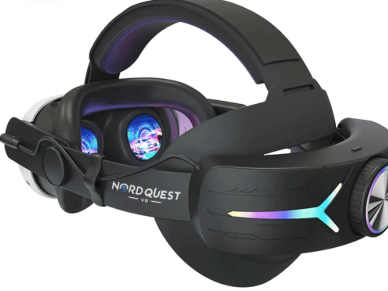Companies are developing pain-mimicking technology for metaverse users to wear
One of the biggest draws to virtual reality is that a person can have a very real feeling experience from the comfort — and safety — of their own homes or preferred locations.

The concept is simple. Go where you want. Do what you want. Act how you want. All while, well, doing nothing at all in the physical realm.
Virtual reality is of course continuing to grow and have a larger impact on the everyday lives of individuals who are both seeking it out or simply living through it.
The metaverse, as it’s now come to be known, is expected to be the next big thing in virtual reality. A second world to live in that’s built entirely in a digital space.
To call it futuristic might be underselling it. A more accurate description could be that the future is now, or at least somewhere down the road.
While Facebook recently rebranded as Meta in preparation for the metaverse, the concept isn’t actually expected to take flight until around the end of the decade.
“A lot of people assume the metaverse is about a location, but one description of it is a period when immersive digital worlds become the primary way we live our lives and spend our time,” Meta CEO Mark Zuckerberg said on a podcast with Lex Fridman.

Bringing the Pain
If one Japanese startup has its way, the metaverse will bring with it a bit more of a “painful” experience than what some may be used to when it comes to virtual reality living.
The startup, H2L Technologies, is in the process of designing wrist bands which are able to inflict electrical shocks to wearers in conjunction with virtual reality happenings.
These shocks can simulate a number of different real-world sensations, such as what it feels like to catch a baseball or be pinched.
“Feeling pain enables us to turn the metaverse world into a real (world), with increased feelings of presence and immersion,” H2L CEO Emi Tamaki told the Financial Times.
In order to make the device as realistic as possible it has been designed to allow its user to feel both the weight and resistance of the action that is being experienced in the metaverse.
“H2L technology conveys weight and resistance feeling to users and avatars on the Metaverse, not only pain,” the company wrote in a tweet.

The device works by detecting the flexing of a wearer’s arm muscles, which allows the device to copy body movements and create the appropriate object weight.
Electrical stimulation is also used to manipulate the arm muscles into mimicking sensations which are experienced by the device wearers and known as proprioceptive senses. In addition to weight and resistance, these senses also convey body motion.
In addition to making the metaverse experience feel more real, it also allows users in the metaverse to achieve a greater innate feeling of the space around them, their own bodies, and the passing of time.
“I realized life was precious so I decided to work on a new field that I really wanted to dig into, as there was no one doing research at the time,” Tamaki told the Financial Times.
Spanish startup OWO, meanwhile, has designed a jacket which is equipped with sensors that enable users to feel different sensations, spanning all the way from gunshots to hugs.
The vest, which has an appearance more similar to a shirt, is designed to be worn directly on the skin and enables wearers to feel sensations on 10 different upper body parts including the arms.
“Before, we had to rely on vision and hearing to create experiences. Now, however, OWO has created a system that allows us to use a new sense which had only existed in the physical dimension: touch,” the company says, on its website.
Some of the sensations a wearer will be able to feel include being punched and stabbed, getting insect bites, or having a bullet exit the body.
The completely wireless vest was designed to have a battery life of eight hours, comes in different sizes, and will be customizable through a mobile app.
Wearers of the vest will be able to differentiate between the heaviness of an object when trying to lift or push it, feel the recoil of a gun, the sensation of falling, and being in a fast-moving vehicle.
OWO says it plans to start selling the vests to the general public beginning in October.

Recreating Real
The idea to “feel” the metaverse is not exclusive to H2L. Meta revealed in November that it is working on creating a haptic vibrating glove which can be used in the metaverse.
The gloves would allow wearers to experience a number of different sensations, such as petting a dog, grabbing an object, or running your hand on a textured surface.
While it wouldn’t be able to recreate the experience exactly, Reality Labs head Michael Abrash says it would still provide one that feels real to the wearer.
“It seems likely to me that if the haptic gloves work out, you’ll be able to pet a dog, but it will be a virtual dog and it will be a slightly different experience,” Abrash told The Verge last year. “But basically — emotionally, experientially — it will feel as real.”
Meta’s glove — which is currently in the prototype stage — is lined with around 15 different inflatable and ridged plastic pads which are designed to fit on the palm, fingertips, and underside of a wearer’s fingers.
Additionally, Meta’s haptic gloves can be used as a virtual reality controller and contain small white markers which allow cameras to track how a wearer’s fingers are moving, and internal sensors which are able to reproduce the bending of a wearer’s fingers.

When worn in a virtual reality or augmented reality setting, the gloves utilize a control system which adjusts the necessary level of inflation and creates pressure points on different parts of the wearer’s hand.
If a wearer is touching something, for example, they will be able to experience the sensation of that object pressing into their skin. Audio and visual cues work in conjunction to help better create the illusion of something being physically touched.
As it stands, Meta’s haptic gloves aren’t quite ready to fall into the hands of consumers, with the technology still needing to be fine-tuned and perfected.
“You could pet a dog, but you wouldn’t feel the texture,” Reality Labs engineer Katherine Healy told The Verge last year. “You need high-density actuation to be able to really get that sensation, and this glove does not do that.”
While it appears there is more work to be done, it seems clear it will be sooner than later that metaverse users will be able to feel the pain.
















Leave a Reply